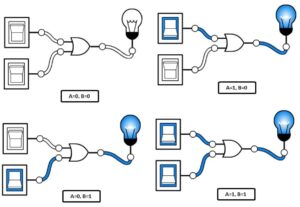Introduction:
Solar panels, often likened to nature’s powerhouses, are ingenious devices that harness the sun’s radiant energy and convert it into usable electricity. They stand as beacons of sustainable technology, offering a clean and renewable energy solution.
In this detailed exploration, we will unveil the intricacies of solar panels, from their historical roots to their remarkable functionality and the promising future they hold.
Evolution of Solar Panels
The evolution of solar panels is a remarkable journey spanning over a century. It began with the discovery of the photovoltaic effect by Edmond Becquerel in the 19th century, a crucial step in understanding how sunlight could be converted into electricity. Charles Fritts furthered this knowledge in 1893, crafting the first genuine solar cell by coating selenium sheets with a thin layer of gold.
The real breakthrough came in 1954 when Bell Laboratories’ Russell Ohl patented the world’s first silicon solar cell. This invention paved the way for the production of the first practical solar panel, marking a significant leap in solar technology. During the 1970s, solar cells made their way into everyday life, embedded in calculators and small electronic devices.
As the years progressed, advancements in materials, manufacturing, and efficiency led to the widespread use of solar panel for various applications. In recent decades, the solar industry has seen exponential growth, with a significant reduction in costs and an increase in efficiency. Today, solar panel are not only powering homes and businesses but also contributing to the global transition to clean and sustainable energy sources, marking a transformative chapter in our history.
Understanding solar panels
Solar panels, composed of interconnected solar cells, are energy converters that capture sunlight and initiate electricity generation. These cells, typically made of silicon, exhibit the photovoltaic effect, where incoming photons from sunlight energize electrons, creating an electric current.
The solar cell structure includes P-type and N-type layers, forming an electric field that guides electron flow. This process directly converts sunlight into usable electricity. Solar panel has a diverse range of applications, from powering remote equipment to providing electricity for homes and businesses.
They represent a sustainable and renewable energy solution, with ongoing advancements enhancing efficiency and affordability, paving the way for a brighter, cleaner future.
Read more: First Solar to Set Up a 3.3 GW Thin Manufacturing Facility in India – techovedas
Analogy:
Imagine a solar panel as a farmer’s field, but instead of crops, it harvests sunlight. Each solar cell acts like a tiny plant, absorbing sunlight and converting it into a valuable resource – electricity. Just as a farmer tends to their crops for a bountiful harvest, the solar panel collects sunlight, harnessing its energy to power homes and businesses.
Just as a well-maintained field yields an abundance of crops, a properly functioning solar panel produces a steady supply of clean, renewable energy. In this analogy, the sun becomes the limitless source of seeds, and the solar panel, our diligent farmer, ensures we have a constant supply of “electricity crops” to sustain us.
Real Life Application
Solar panels have transcended their role as a niche technology, becoming integral in various aspects of modern life. Their versatility and sustainable energy generation make them indispensable in an array of real-world applications, contributing to a greener and more sustainable future. Here, we explore some prominent instances where solar panels are making a tangible impact.
Residential Rooftops
Homeowners are increasingly turning to solar panels to generate their electricity. Installed on rooftops, these panels harness the sun’s energy, reducing reliance on conventional power sources and lowering utility bills.
Commercial Enterprises
Businesses and industries are adopting solar panel to power their operations. This transition not only leads to significant cost savings but also aligns with corporate sustainability goals, demonstrating a commitment to environmental stewardship.
Off-Grid and Remote Locations
In remote or off-grid areas, solar panels provide a reliable source of electricity. They power cabins, telecommunications equipment, and water pumping stations, overcoming the challenges of limited access to conventional power grids.
Solar-Powered Transportation
It is integrated into various modes of transportation, including cars, buses, and boats. These vehicles utilize sunlight to generate power, offering a sustainable alternative to traditional fossil fuels.
Agricultural Advancements
Farmers employ solar panels to power water pumps, irrigation systems, and other agricultural machinery. This empowers efficient and sustainable farming practices, reducing reliance on non-renewable energy sources.
From residential rooftops to remote locations and even in the realm of transportation and agriculture, solar panels have found their way into numerous aspects of our lives. Their tangible impact on energy sustainability and cost savings highlights their pivotal role in shaping a greener future for generations to come.
Follow us on LinkedIn for everything around Semiconductors & AI
Types of solar panels
There are several types of solar panels available, each utilizing different technologies and materials to convert sunlight into electricity. Here are the most common types:
Monocrystalline Solar Panels:
- Made from single-crystal silicon, they are highly efficient and space-efficient, making them ideal for situations with limited space.
Polycrystalline Solar Panels:
- Composed of multiple silicon crystals, they are less expensive to produce than monocrystalline panels but slightly less efficient. They are a popular choice for residential installations.
Thin-Film Solar Panels:
- Made from various materials, including amorphous silicon, cadmium telluride, and copper indium gallium selenide (CIGS). They are flexible, lightweight, and can be used in a variety of applications.
Amorphous Silicon (a-Si) Solar Panels:
- A type of thin-film solar panel, they use non-crystalline silicon. They are less efficient than crystalline panels but are cheaper to produce and perform better in low-light conditions.
Cadmium Telluride (CdTe) Solar Panels:
- Another thin-film option, they are cost-effective and have a relatively high efficiency rate. They are commonly used in large-scale solar projects.
Copper Indium Gallium Selenide (CIGS) Solar Panels:
- A newer thin-film technology, CIGS panels offer a good balance of efficiency and cost. They are flexible and can be integrated into various surfaces.
Bifacial Solar Panels:
- These panels can capture sunlight on both sides, improving overall efficiency. They are often used in situations where light can be reflected onto the back of the panel.
Perovskite Solar Panels:
- A newer and highly promising technology, perovskite solar cells use a unique crystal structure to efficiently convert sunlight into electricity. They have the potential to be highly efficient and cost-effective.
Organic Photovoltaic (OPV) Solar Panels:
- These solar panels use organic compounds to generate electricity. They are lightweight, flexible, and have the potential for low-cost production.
Dye-Sensitized Solar Cells (DSSC):
- DSSCs use a dye to capture sunlight and generate electricity. They are cost-effective and can work well in low-light conditions.
Choosing the right type of solar panel depends on factors like available space, budget, efficiency requirements, and specific applications. Each type has its unique advantages and is suitable for different situations.
How do they work?
A solar cell, also known as a photovoltaic cell, is a device that converts sunlight (solar energy) into electricity. The basic operation of a solar cell involves the following steps:
Absorption
Photon Absorption: Solar cells are made of a semiconductor material, often silicon. When sunlight (which is composed of photons) strikes the surface of the solar cell, some of these photons are absorbed by the semiconductor material. Each photon carries a certain amount of energy.
Generation of Electron-Hole Pairs: When photons are absorbed, they transfer their energy to electrons in the semiconductor material, causing these electrons to become energized and jump to a higher energy level. This creates what’s called an “electron-hole pair.” The electron moves to a higher energy level, leaving behind a positively charged “hole” where the electron used to be.
Separation of Charges: The energized electrons and holes are now free to move within the semiconductor material. Due to the internal structure of the solar cell, these charges are separated, with the electrons typically moving toward the front surface of the cell and the holes moving toward the back surface.
Generation
Electric Current Generation: The separated electrons and holes create an electric potential (voltage) within the solar cell. This voltage difference drives the flow of electrons, creating an electric current. This is the electricity generated by the solar cell.
Collection of Current: Conductive metal contacts on the front and back of the solar cell capture the electric current and channel it out of the cell. This electricity can then be used to power electrical devices or stored in batteries.
Conversion of Direct Current (DC): The electricity generated by a solar cell is in the form of direct current (DC). In many applications, such as powering homes or charging devices, it needs to be converted into alternating current (AC) using an inverter, as most household appliances use AC.

Image Credits: MrSolar.com
The electricity generated by the solar cells is in direct current (DC) form. In many applications, like homes and businesses, an inverter converts this DC into alternating current (AC), suitable for powering appliances.
Solar panels continue to collect sunlight during daylight hours, consistently generating electricity. Any surplus electricity produced can be fed back into the grid, making solar panels a sustainable and efficient source of clean energy.
Advantages of Solar Panels
Solar panels have emerged as a transformative technology in the realm of renewable energy. By harnessing the abundant power of sunlight, they offer a range of advantages that revolutionize the way we generate electricity. The key benefits of adopting solar panels, from financial savings to environmental sustainability.
Sustainable Energy Source
Solar panels tap into a clean, renewable energy source – sunlight. Unlike fossil fuels, sunlight is abundant and inexhaustible, ensuring a long-term and sustainable energy solution.
Reduced Energy Costs
Once installed, solar panels significantly reduce electricity bills. By generating their power, homeowners and businesses can decrease their dependence on traditional utility grids, leading to substantial financial savings over time.
Environmental Impact
Solar energy is a clean, green alternative to conventional power sources. It produces no greenhouse gases or harmful emissions, contributing to a reduction in air pollution and combatting climate change.
Energy Independence
Solar panels provide a degree of energy independence. This is especially crucial in remote areas where access to traditional power grids is limited. It empowers communities to rely on their self-generated electricity.
Low Maintenance and Longevity
Solar panels require minimal maintenance. With no moving parts, they are robust and durable, often lasting for 25 years or more. This longevity ensures a reliable and cost-effective energy solution.
Job Creation and Economic Growth
The solar industry fosters job creation and economic growth. Installation, maintenance, and manufacturing of solar panels create employment opportunities, stimulating local economies and contributing to a sustainable energy sector.
In essence Solar panels represent a pivotal shift towards a more sustainable and eco-conscious energy landscape. Their numerous advantages, from financial savings to environmental stewardship, make them an integral component of the global transition towards clean energy sources. Embracing solar technology not only benefits individual households and businesses but also contributes to a brighter, more sustainable future for our planet.
Innovations Driving Solar Panel Efficiency
Advancements in solar panel technology have been instrumental in enhancing their efficiency and expanding their applications. These innovations, ranging from material improvements to manufacturing techniques, are propelling it towards even greater performance. Let’s delve into the key breakthroughs driving the efficiency of solar panels.
High-Efficiency Solar Cells:
Cutting-edge solar cells are engineered to convert a higher percentage of sunlight into electricity. Innovations like PERC (Passivated Emitter Rear Contact) and bifacial cells have significantly improved conversion rates, maximizing energy production.
Thin-Film Technology:
Thin-film solar cells utilize lighter, flexible materials, allowing for easier integration into a variety of settings. These cells are more adaptable and efficient in capturing sunlight, particularly in low-light conditions.
Multi-Junction Cells:
Multi-junction solar cells stack multiple layers of semiconductors, each tuned to capture different wavelengths of sunlight. This technology, initially used in space applications, has made its way into terrestrial solar panel, boosting efficiency.
Anti-Reflective Coatings:
Specialized coatings on its minimize the reflection of sunlight, ensuring more photons are absorbed by the cells. This advancement maximizes energy generation, particularly in regions with intense sunlight.
Tracking Systems:
Solar tracking systems follow the sun’s path throughout the day, optimizing the angle at which sunlight hits the panels. This dynamic adjustment significantly increases energy output compared to fixed-panel installations.
Improved Inverters:
Efficient inverters convert DC electricity from solar panels into AC power for household or grid use. Technological advancements have reduced losses during this conversion process, increasing overall system efficiency.
Smart Grid Integration:
Integrating solar panels with smart grid technology enables efficient distribution and consumption of electricity. This synchronization ensures that excess energy storage or feeding back into the grid minimizes wastage.
AI and Machine Learning:
Researchers are using artificial intelligence algorithms and machine learning models to optimize the performance of solar panels. These systems analyze data on weather conditions, panel temperature, and energy production patterns to make real-time adjustments for maximum efficiency.
The continuous pursuit of higher efficiency in solar panel through technological advancements is reshaping the renewable energy landscape. These innovations not only increase energy output but also make solar power a more accessible and viable option for a wide range of applications. As the efficiency of solar panel continues to advance, they play an increasingly crucial role in the global transition towards sustainable and clean energy sources.
The Bright Future of Solar Panels
As the world pivots towards sustainable energy solutions, the future of solar panels holds immense promise. Technological breakthroughs and innovative research are shaping a new era in solar energy generation, revolutionizing the way we harness sunlight. This article explores the anticipated advancements that will define the future landscape of solar panels.
Next-Generation Solar Cell Technologies
Future solar panels will incorporate advanced materials and designs, such as perovskite cells and organic photovoltaics, to significantly increase conversion efficiency and reduce production costs.
Energy Storage Solutions
Integrated energy storage systems will become standard, allowing solar panels to store excess energy for later use, overcoming the intermittent nature of sunlight.
Solar-Integrated Architecture
Architectural designs will seamlessly incorporate solar panels into building materials, creating aesthetically pleasing, energy-efficient structures that generate their own power.
Solar-Powered Transportation
The automotive industry will witness a surge in solar-powered vehicles, from cars to drones, utilizing integrated solar panels for sustainable and cost-effective transportation.
Artificial Intelligence Optimization
Advanced AI algorithms will enhance solar panel efficiency through real-time monitoring, predictive maintenance, and optimized energy production.
The future of solar panels is marked by innovation, efficiency, and integration. With ongoing research and development, solar energy will play a pivotal role in driving the transition towards a greener, more sustainable global energy landscape..
Conclusion:
Solar panels epitomize the fusion of nature’s brilliance with human ingenuity. Their functionality, historical roots, and promising future underscore their significance in the global pursuit of sustainable energy. As we embrace the power of solar panels, we illuminate a path towards a brighter, cleaner, and more sustainable future for generations to come.








